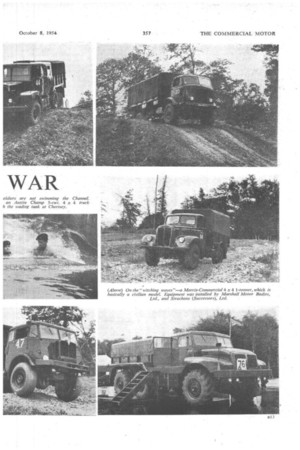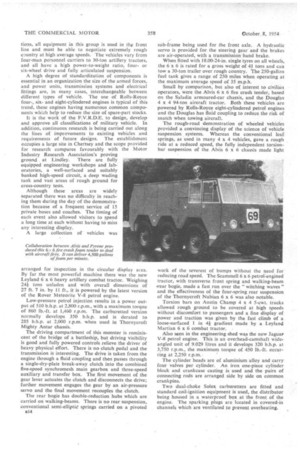WHEELS WAR
Page 46

Page 47

Page 48

If you've noticed an error in this article please click here to report it so we can fix it.
AN exhibition of British military vehicles which, by its display of technical progress in all fields of transport, rivalled in interest the Commercial Motor Show, was given before a large gathering of home and overseas visitors last week. The demonstration was arranged by the Ministry of Supply in
conjunction with the Society of Motor Manufacturers and Traders, and took place at the Fighting Vehicles Research and Development Establishment at Chertsey, Surrey.
Among many interesting exhibits were several which were on show for the first time. These included the largest tractor in use in this country, a high-powered V-R petrol engine and a gas-turbine-engined tracked vehicle.
The object of the exercise was to demonstrate the special features of Army vehicles which also make them suitable for exceptional work in certain civilian fields, with particular emphasis on export trade. The success of the project was due in no small measure to the excellent organization of events. Apart from that, the demonstrations of tracked armoured vehicles in action and the appearance of the world's first gas-turbine track-laying vehicle were of absorbing interest.
Wheeled vehicles in use with the armed forces are divided into three general cate gories. The first group carries the nomenclature, CL., and consists basically of lightand medium-weight civilian models which are not modified except possibly in respect of bodywork. Such vehicles are used solely for the conveyance of supplies in base areas where good roads are available. The second group comprises G.S. vehicles. These are standard civilian chassis which usually incorporate a driven front axle, a power-driven winch, a limited amount of waterproofing and a ,good ground clearance. G.S. vehicles are used. to provide lines of communication between base and forward fighting areas and as such have to be capable of a reasonably good crosscountry performance.
The last, and most important, section consists of combat vehicles. Built to Ministry of Supply specifica lions, all equipment in this group is used in the front line and must be able to negotiate extremely rough country at high average speeds. The vehicles vary from four-man personnel carriers to 30-ton artillery tractors, and all have a high power-to-weight ratio, fouror six-wheel drive and fully articulated suspension.
A high degree of standardization of components is essential in an organization the size of the armed forces, and power units, transmission systems and electrical fittings are, in many cases, interchangeable between different types of vehicle. The use of Rolls-Royce four-, sixand eight-cylindered engines is typical of this trend, these engines having numerous common components which help to reduce the size of spare-part stocks. It is the work of the F.V.R.D.E. to design, develop and approve all classifications of military vehicle. In addition, continuous research is being carried out along the lines of improvements to existing vehicles and requirements of future designs. The establishment occupies a large site in Chertsey and the scope provided for research compares favourably with the Motor Industry Research Association's proving ground . at Lindley. There are fully equipped engineering workshops and laboratories, a well-surfaced and suitably banked high-speed circuit, a deep wading tank and vast areas of rough ground for cross-country tests.
Although these areas are widely separated there was no difficulty in reaching them during the day of the demonstra tion because of a frequent service of 15 private buses and coaches. The timing of each event also allowed visitors to spend a long time at each without having to miss any interesting display.
A large collection of vehicles was arranged for inspection in the circular display area. By far the most powerful machine there was the new Leyland 6 x 6 heavy artillery combat tractor. Weighing 241 tons unladen and with overall dimensions of 27 ft. 7 in. by lift., it is powered by the latest version of the Rover Meteorite V-8 petrol engine.
Low-pressure petrol injection results in a power output of 510 b.h.p. at 2,800 r.p.m., with a maximum torque of 860 lb.-ft. at 1,460 r.p.m. The carburetted version normally develops 350 b.h.p. and is derated to 285 b.h.p. at 2,000 r.p.m. when used in Thornycroft Mighty Antar chassis.
The driving compartment of this monster is reminiscent of the bridge of a battleship, but driving visibility is good and fully powered controls relieve the driver of heavy physical effort. There is no clutch pedal and the transmission is interesting. The drive is taken from the engine through a fluid coupling and then passes through a single-dry-plate break-away clutch into the combined five-speed synchromesh main gearbox and three-speed auxiliary and transfer box. The first movement of the gear lever actuates the clutch and disconnects the drive; further movement engages the gear by an air-pressure servo and the final movement recouples the clutch.
The rear bogie has double-reduction hubs which are carried on walking-beams. There is no rear suspension, conventional semi-elliptic springs carried on a pivoted B14 sub-frame being used for the front axle. A hydraulic servo is provided for the steering gear and the brakes are air-operated, with a transmission hand brake.
When fitted with 18.00-24-in, single tyres on all wheels, the 6 x 6 is rated for a gross weight of 41 tons and can tow a 30-ton trailer over rough country. The 250-gallon fuel tank gives a range of 250 miles when operating at the maximum average speed of 35 m.p.h.
Small by comparison, but also of interest to civilian operators, were the Alvis 6 x 6 fire crash tender, based on the Saladin armoured-car chassis, and the Douglas 4 x 4 94-ton aircraft tractor. Both these vehicles are powered by Rolls-Royce eight-cylindered petrol engines and the Douglas has fluid coupling to reduce the risk of snatch when towing aircraft.
The rough-road demonstration of wheeled vehicles provided a convincing display of the science of vehicle suspension systems. Whereas the conventional leaf springs, as used in many 4 x 4 vehicles, gave a rough ride at a reduced speed, the fully independent torsionbar suspension of the Alvis 6 x 6 chassis made light work of the severest of bumps without the need for reducing road speed. The Scammell 6 x 6 petrol-engined tractor, with transverse front spring and walking-beam Torsion bars on Austin Champ 4 x 4 5-cwt. trucks allowed rough ground to be covered at high speeds without discomfort to passengers and a fine display of power and traction was given by the fast climb of a loose-surfaced 1 in 41gradient made by a Leyland Martian 6 x 6 combat tractor. Also seen in the engineering shed was the new Jaguar V-8 petrol engine. This is an overhead-camshaft wideangled unit of 9.029 litres and it develops 320 b.h.p. at 3,750 r.p.m., the maximum torque of 450 lb.-ft. occurring at 2,250 r.p.m. The cylinder heads are of aluminium alloy and carry four valves per cylinder. An iron one-piece cylinder block and crankcase casting is used and the pairs of connecting rods are arranged side by side on common crankpins. Two dual-choke Solex carburetters are fitted and standard coil-ignition equipment is used, the distributor being housed in a waterproof box at the front of the engine. The sparking plugs are located in covered-in channels which are ventilated to prevent overheating.Tags




























































































